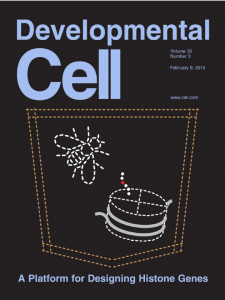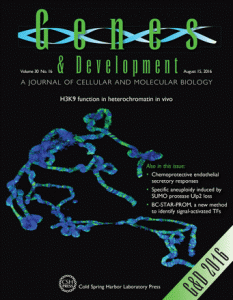Histone PTMs & Genomics
Salzler H.R., Vandadi V., McMichael B.D., Brown J.C., Boerma S.A., Leatham-Jensen M.P., Adams K.M., Meers M.P., Simon J.M., Duronio R.J., McKay D.J. and Matera A.G. (2023). Distinct roles for canonical and variant histone H3 lysine 36 in Polycomb silencing. Science Advances 9: eadf2451. PMC9977188
McPherson J-M.E., Grossman L.C., Salzler H.R., Armstrong R.L., Kwon E., Matera A.G., McKay D.J. and Duronio R.J. (2023). Reduced histone gene copy number disrupts Drosophila Polycomb function. Genetics 224: iyad106. PMID: 37279945
Crain A.T., Klusza S., Armstrong R.L., Santa Rosa P., Temple B.R., McKay D.J., Matera A.G.* and Duronio R.J.* (2022). Distinct developmental phenotypes result from mutation of Set8/KMT5A and histone H4 lysine 20 in Drosophila melanogaster. Genetics 221: iyac054. (*Co-corresponding authors)
Leatham-Jensen M., Uyehara CM., Strahl B.D., Matera A.G., Duronio R.J., McKay D.J. (2019). Lysine 27 of replication-independent histone H3.3 is required for Polycomb target gene silencing but not for gene activation. PLOS Genetics 15: e1007932. PMC6370247
Meers M.P., Adelman K., Duronio R.J., Strahl B.D., McKay D.J., Matera A.G. (2018). Transcription start site profiling uncovers divergent transcription and enhancer-associated RNAs in Drosophila melanogaster. BMC Genomics19:157. PMC5822475
Meers M.P., Leatham-Jensen M., Penke T.J.R., McKay D.J., Duronio R.J. and Matera A.G. (2018). An animal model for genetic analysis of multi-gene families: Cloning and transgenesis of large tandemly-repeated histone gene clusters. Methods in Molecular Biology 1832:309-325. PMID: 30073535
Armstrong R.L., Penke T.J.R., Strahl B.D., Matera A.G., McKay D.J., MacAlpine D.M. and Duronio R.J. (2018). Chromatin conformation and transcriptional activity are permissive regulators of DNA replication initiation in Drosophila. Genome Research 28:1688-1700. PMC6211642
Penke T.J.R., McKay D.J., Strahl B.D., Matera A.G. and Duronio R.J. (2018). Functional redundancy of variant and canonical histone H3 lysine 9 modification in Drosophila. Genetics 208: 229-244. Epub 13 Nov 2017. PMC5753860
Meers M.P., Henriques T., Lavender C.J., McKay D.J., Strahl B.D., Duronio R.J., Adelman K. and Matera A.G. (2017). Histone gene replacement reveals a post-transcriptional role for H3K36 in maintaining metazoan transcriptome fidelity. eLife 6: e23249. doi:10.7554/eLife.23249. PMC540492
Penke T.J.R., McKay D.J., Strahl B.D., Matera A.G.and Duronio R.J. (2016). Replication-dependent H3K9 is essential for formation of pericentromeric heterochromatin and transposon silencing, but not for completion of Drosophiladevelopment. Genes & Development 30: 1866-1880. PMC5024684 (Cover article)
McKay D.J., Klusza S., Meers M.P., Penke T.J.R., Curry K.P., McDaniel S.L., Malek P.Y, Cooper S.W., Tatomer D.C., Lieb J.D., Strahl B.D., Duronio R.J.* and Matera A.G.* (2015). Interrogating the function of metazoan histones using engineered gene clusters. Developmental Cell 32: 373-386. PMC4385256 (*Co-corresponding authors; Cover article)
Barcaroli D., Bongiorno-Borbone L., Terrinoni A., Hofmann T.G., Rossi M., Knight R.A., Matera A.G., Melino G. and De Laurenzi V. (2006). FLASH is required for histone transcription and S-phase progression. Proc. Natl. Acad. Sci. USA 103: 14808-14812.
Zhao J., Kennedy B.K., Lawrence B.D., Barbie D.A., Matera A.G., Fletcher J.A. and Harlow E. (2000). NPAT links cyclin E-CDK2 to the regulation of replication-dependent histone gene transcription. Genes & Development 14: 2283-2297.
Wang Z-F., Krasikov T., Frey M.R., Wang J., Matera A.G. and Marzluff W.F. (1996). Characterization of the mouse histone gene cluster on chromosome 13: 45 histone genes in three patches spread over 1 Mb. Genome Research6: 688-701.
Wang Z-F., Krasikov T., Frey M.R., Wang J., Matera A.G. and Marzluff W.F. (1996). Characterization of the mouse histone gene cluster on chromosome 13: 45 histone genes in three patches spread over 1 Mb. Genome Research 6: 688-701.
Turner P.C., Whalen A., Schümperli D. and Matera A.G. (1996). The Bona Fide mouse U7 snRNA gene maps to a different chromosome than two U7 pseudogenes. Genomics 31: 250-252.



